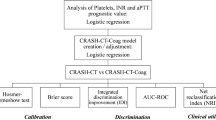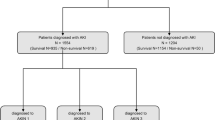Summary
Background
Accurate assessment of injury severity is critical for decision making related to the prevention, triage, and treatment of several injured patients. Early estimation of mortality risk of critically injured patients is mandatory for adequate therapeutic strategies. Current risk stratification relies on clinical diagnosis and scoring systems. In our study, we hypothesized whether a simple laboratory test, the CK/CK-MB ratio, could help improving risk prediction in severely traumatized patients.
Methods
In a 9-year period, 328 nonselected trauma patients were included in our retrospective study at a Level I Trauma Center up to September 2002. Data for this study were obtained from our computerized trauma database, established in September 1992.
Results
In our study population, we could show a negative correlation between Injury Severity Score (ISS) and leukocytes. A positive correlation was detected for liver enzymes and CK-MB. The correlation between ISS and Na+ was significant. No correlation between ISS, K+, and Hb/Ht could be observed. Exitus was associated with ISS, alteration in thrombocytes, CK, CK-MB, CRP, Crea, and Na+.
Conclusion
In our study population, CK-MB levels showed a significant correlation with overall surveillance in polytraumatized patients. In our opinion, this might suggest that CK-MB levels could be taken as an indirect predictor for survival. Our findings need to be proven in further prospective clinical trials.
Zusammenfassung
Hintergrund
Das richtige Erkennen des Schweregrades einer Verletzung ist entscheidend für die Triage und die Behandlung von Schwerstverletzten. Das frühe Abschätzen des Mortalitätsrisikos bei lebensgefährlich verletzten Patienten ist eine Grundvoraussetzung für eine adäquate und zielführende Behandlung. Aktuelle Risikoeinschätzung basiert auf klinischen Diagnosen und Scoringsystemen. In unsere Studie haben wir die Hypothese untersucht, dass ein einfacher Labortest, CK/CK-MB Ratio, möglicherweise die Risikoeinschätzung für die Behandlung von Schwerstverletzten verbessern könnte.
Methodik
In einem Zeitraum von 9 Jahren (2002–2011) konnten 328 nicht selektierte Polytraumapatienten an einem Level I Krankenhaus in unsere Studie inkludiert werden. Die Daten wurden aus dem elektronischen Patienteninformationssystem erhoben, welches im September 1992 erstellt wurde.
Ergebnisse
In unserer Studienpopulation konnten wir eine negative Korrelation zwischen ISS (Injury Severity Score) und Leukozyten. Eine positive Korrelation konnte für Leberenzyme und CK-MB erhoben werden. Die Korrelation zwischen ISS und Na+ war signifikant. Zwischen ISS, K+ und Hb/HK konnte keine Korrelation beobachtet werden. Exitus war assoziiert mit ISS, erhöhten Thrombozyten, CK, CK-MB, CRP, Crea and Na+.
Schlussfolgerung
Mit unserer Studie konnten wir eine signifikante Korrelation zwischen CK-MB Werten und dem Gesamtüberleben in Polytrauma-Patienten zeigen. Daher wäre es möglich, dass in Zukunft CK-MB Werte als Vorhersageparameter für das Überleben dienen könnten. Unsere Ergebnisse müssen durch weiter prospektive Studien bestätigt werden.

Similar content being viewed by others
References
Bogner V, Keil L, Kanz KG, Kirchhoff C, et al. Very early posttraumatic serum alterations are significantly associated to initial massive RBC substitution, injury severity, multiple organ failure and adverse clinical outcome in multiple injured patients. Eur J Med Res. 2009;14:284–91.
Bouget J, Daubert JC, Catheline M, Beauverger Y, et al. Value of serum myoglobin in acute myocardial infarction. Kinetic study. Arch Mal Coeur Vaiss. 1981;74:1205–15.
Carr ME Jr, Masullo LN, Brown JK, Lewis PC. Creatine kinase BB isoenzyme blood levels in trauma patients with suspected mild traumatic brain injury. Mil Med. 2009;174:622–5.
Davis T, Dinh M, Roncal S, Byrne C, et al. Prospective evaluation of a two-tiered trauma activation protocol in an Australian major trauma referral hospital. Injury. 2010;41:470–4.
Deitch EA, Livingston DH, Lavery RF, Monaghan SF, Bongu A, Machiedo GW. Hormonally active woman tolerate shock-trauma better than do man: a prospective study of over 4000 trauma patients. Ann Surg. 2007;246(3):447–55.
De Winter DJ, Koster RW, Sturk A, Sanders GT. Value of myoglobin, troponin T, and CK-MB mass in ruling out an acute myocardial infarction in the emergency room. Circulation. 1995;92:3401–7.
Foreman BP, Caesar RR, Parks J, Madden C, et al. Usefulness of the abbreviated injury score and the injury severity score in comparison to the Glasgow Coma Scale in predicting outcome after traumatic brain injury. J Trauma. 2007;62:946–50.
Gao YY, Zhang DF, Li H, Liu R, et al. Proteomic approach for caudal trauma-induced acute phase proteins reveals that creatine kinase is a key acute phase protein in amphioxus humoral fluid. J Proteome Res. 2007;6:4321–9.
Guzzo JL, Bochicchio GV, Napolitano LM, Malone DL, et al. Prediction of outcomes in trauma: anatomic or physiologic parameters. J Am Coll Surg. 2005;201:891–7.
Harwood PJ, Giannoudis PV, Probst C, Van Griensven M, et al. Polytrauma Study Group of the German Trauma Society. Which AIS based scoring system is the best predictor of outcome in orthopaedic blunt trauma patients. J Trauma. 2006;60:334–40.
Hildebrand F, Pape HC, Krettek C. The importance of cytokines in the posttraumatic inflammatory reaction. Unfallchirurg. 2005;108:793–4.
Karmen A, Wrobelewski F, Ladue JS. Transaminase activity in human blood. J Clin Invest. 1955;34:126–31.
Karras DJ, Kane DL. Serum markers in the emergency department diagnosis of acute myocardial infarction. Emerg Med Clin North Am. 2001;19:321–37.
Keel M, Trentz O. Pathophysiology of polytrauma. Injury. 2005;36:691–709.
Kingston R, O’Flanagan SJ. Scoring systems in trauma. Ir J Med Sci. 2000;169:168–72.
Klaase JM, Swaanenburg JC, Zimmerman KW, de Jongste MJ, et al. The elevation of serum creatine kinase-MB level in trauma patients: misleading impression of myocardial damage. Ned Tijdschr Geneeskd. 1998;142:962–5.
Kumbhare D, Parkinson W, Dunlop B. Validity of serum creatine kinase as a measure of muscle injury produced by lumbar surgery. J Spinal Disord Tech. 2008;21:49–54.
Lenz A, Franklin GA, Cheadle WG. Systemic inflammation after trauma. Injury. 2007;38:1336–45.
Liu CC, Wang CY, Shih HC, Wen YS, et al. Prognostic factors for mortality following falls from height. Injury. 2009;40:595–7.
Lott JA, Stang JM. Differential diagnosis of patients with abnormal serum creatine kinase isoenzymes. Clin Lab Med. 1989;9:627–42.
Ma YF, Sheng L, Gu J, Zhang M, et al. Analysis of clinical risk factors associated with mortality of severely injured multiple trauma patients with acute lung injury. Chin Med J (Engl). 2009;122:701–5.
Mommsen P, Frink M, Pape HC, van Griensven M, et al. Elevated systemic IL-18 and neopterin levels are associated with posttraumatic complications among patients with multiple injuries: a prospective cohort study. Injury. 2009;40:528–34.
Neumeier D, Prellwitz W, Sandel P, Knedel M. Studies of activity kinetic of isoenzyme CK-MB in serum after myocardial infarction. Klin Wochenschr. 1978;56:449–56.
Pamerneckas A, Adukauskiene D, Macas A. Multiple trauma: evaluation of patient’s condition and local injuries by trauma classification systems. Medicina (Kaunas). 2002;38:685–94.
Pfeifer R, Tarkin IS, Rocos B, Pape HC. Patterns of mortality and causes of death in polytrauma patients—has anything changed. Injury. 2009;40:907–11.
Probst C, Zelle B, Panzica M, Lohse R, et al. Clinical Re-Examination 10 or More Years After Polytrauma: Is There a Gender Related Difference. J Trauma. 2010;68:706–11.
Raum MR, Nijsten MW, Vogelzang M, Schuring F, et al. Emergency trauma score: an instrument for early estimation of trauma severity. Crit Care Med. 2009;37:1972–7.
Ruppert M, van Hee R. Creatinine-kinase-MB determination in non-cardiac trauma: its difference with cardiac infarction and its restricted use in trauma situations. Eur J Emerg Med. 2001;8:177–9.
Rutledge R. The injury severity score is unable to differentiate between poor care and severe injury. J Trauma. 1996;40:944–50.
Rutledge R. Injury severity and probability of survival assessment in trauma patients using a predictive hierarchical network model derived from ICD-9 codes. J Trauma. 1995;38:590–7.
Sartorius D, Le Manach Y, David JS, Rancurei E, et al. Mechanism, glasgow coma scale, age, and arterial pressure (MGAP): a new simple prehospital triage score to predict mortality in trauma patients. Crit Care Med. 2010;38:831–7.
Sobel BE, LeWinter MM. Ingenuous interpretation of elevated blood levels of macromolecular markers of myocardial injury: a recipe for confusion. J Am College of Cardiol. 2000;35:1355–8.
Spindler-Vesel A, Wraber B, Vovk I, Kompan L. Intestinal Permeability and Cytokine Inflammatory Response in Multiply Injured Patients. J Interferon Cytokine Res. 2006;26:771–6.
Strecker W, Gebhard F, Perl M, Rager J, et al. Biochemical characterization of individual injury pattern and injury severity. Injury. 2003;34:879–87.
Wu J, Sheng L, Wang S, Li Q, et al. Analysis of clinical risk factors associated with the prognosis of severe multiple-trauma patients with acute lung injury. J Emerg Med. 2009. Epub ahead of print.
Yian EH, Gullahorn LJ, Loder RT. Scoring of pediatric orthopaedic polytrauma: correlations of different injury scoring systems and prognosis for hospital course. J Pediatr Orthop. 2000;20:203–9.
Conflict of interest
We hereby certify that there are no actual or potential conflicts of interest for the authors of the present paper. There are no undisclosed financial or personal relationships with other people or organizations that could inappropriately influence our work. There are no potential conflicts of interest that include employment, consultancies, stock ownership, honoraria, paid expert testimony, patent applications/registrations, and grants or other funding.
Author information
Authors and Affiliations
Corresponding author
Rights and permissions
About this article
Cite this article
Kovar, F., Aldrian, S., Endler, G. et al. CK/CK-MB ratio as an indirect predictor for survival in polytraumatized patients. Wien Klin Wochenschr 124, 245–250 (2012). https://doi.org/10.1007/s00508-012-0155-8
Received:
Accepted:
Published:
Issue Date:
DOI: https://doi.org/10.1007/s00508-012-0155-8




